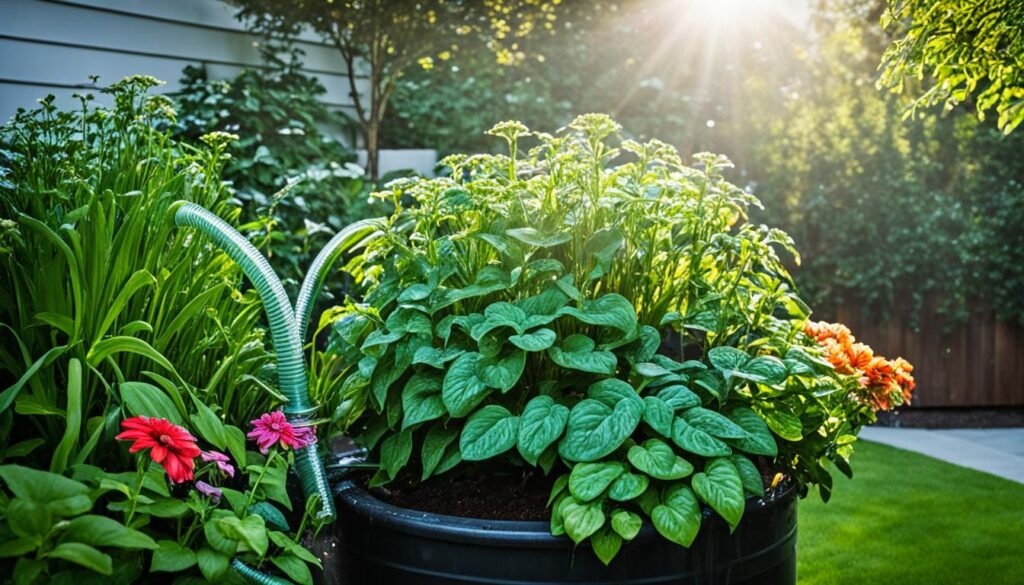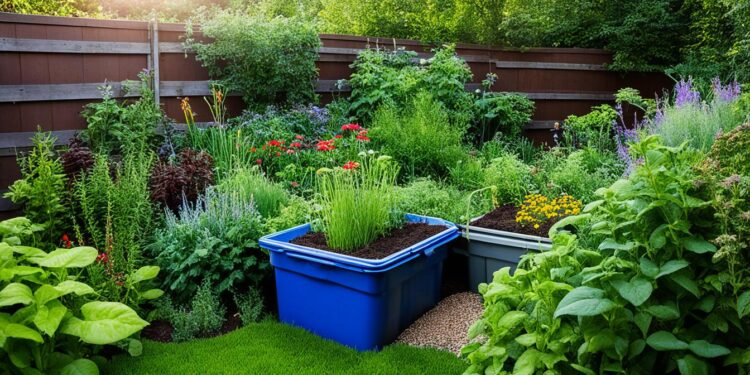In today’s world, caring for the environment is key. Creating a sustainable garden is a great way to connect with nature. It lets you make a space that’s good for your soul and the planet. This guide will show you how to make a garden that’s eco-friendly and supports a greener future.
Sustainable gardening means more than just having pretty plants. It’s about building a garden that works with nature. You’ll pick the right plants, manage pests, and use organic fertilizers. This way, your garden will be healthy and strong for a long time. By doing this, you help keep our environment balanced.
Whether you’re new to gardening or have been doing it for years, this guide has what you need. It will give you the skills to make a garden that’s sustainable and needs little extra help. Get ready to start a journey of caring for the earth through gardening. Your efforts can really help make the future greener.
Sustainable Gardening: Embrace Nature’s Harmony
Sustainable gardening is more than a trend. It’s a way to make your outdoor space a thriving, self-sustaining ecosystem. By using sustainable gardening, you can create an eco-friendly garden. This garden will work with nature, lessen your environmental impact, and make your landscape healthier and more beautiful.
Understanding the Principles of Sustainable Gardening
At the core of sustainable gardening are a few key principles. These include mimicking nature, reducing waste, saving resources, and boosting biodiversity. By following these, you can make a garden that looks great and is strong, self-managing, and good for the local ecosystem.
The Benefits of a Sustainable Garden Ecosystem
Using sustainable gardening brings many rewards. Your garden will have healthier soil, drawing in more pollinators and beneficial insects. This means better plant growth, more crops, and less need for harmful chemicals. Plus, a sustainable garden can store carbon, fight climate change, and be a safe place for wildlife, helping the local environment.
By using nature-based gardening and regenerative horticulture, you can make a garden that’s both pretty and supports a balanced ecosystem. This journey lets you connect with nature and care for the land, one garden at a time.
Planning Your Sustainable Garden Layout
Planning is key to a successful sustainable garden. Think about eco-friendly garden layouts and nature-inspired designs. Look at your space, sun exposure, and how to support biodiversity and save water. This way, you make a garden that works well with nature.
First, check out your garden’s layout and its special features. Think about how the sun moves and affects your garden. This helps you place plants in the best spots for sunlight.
Also, consider your land’s shape and use features like raised beds or rainwater systems. These help with water use and stop soil from washing away.
When designing your garden, aim for a layout that helps many different plants live together. Use native plants like trees, shrubs, and flowers to draw in pollinators and insects. Arrange your plants to make different areas that support a healthy ecosystem. This makes your garden look good and helps the environment.
Choosing the Right Plants for Your Climate
Starting a sustainable garden means picking the right plants. Native plants are key for an eco-friendly garden. They fit well with your local climate because they’re adapted to it.
Native Plants: The Foundation of a Sustainable Garden
Native plants are vital for sustainable gardens. They work well with local wildlife and soil. Using them helps your garden look great and supports the local ecosystem.
Companion Planting: Enhancing Growth and Deterring Pests
Companion planting boosts your garden’s health. It pairs plants to help each other grow and keep pests away. This method uses nature to control pests, making your garden safe for the environment.

Choosing native plants and companion planting makes your garden sustainable. It looks good and helps the local ecosystem. This approach makes your garden a peaceful, thriving space.
Nature: Nurturing Your Garden’s Biodiversity
Creating a sustainable garden is more than just about beauty. It’s about building a home for a wide variety of life. By using wildlife-friendly gardening, you can make your garden a place of wonder. This approach helps balance different species and supports the environment.
To boost biodiversity, add different food sources and homes for various creatures. Plant native plants to draw in bees, butterflies, and hummingbirds. These creatures are key for pollination and your garden’s health. Also, include bird baths, log piles, and areas left wild to welcome insects, amphibians, and small mammals.
Keeping your garden balanced is key to its health and strength. By supporting biodiversity, you create a system where every creature has a role. From decomposers to predators, this balance helps control pests and diseases naturally. This means you can avoid harmful chemicals and keep your garden healthy.
Start your sustainable gardening path by watching the variety of life grow in your garden. By caring for your garden’s diversity, you make a beautiful space and help the local ecosystem. Enjoy the beauty of wildlife-friendly gardening and see your garden come alive with nature’s sounds.
Composting: Nature’s Way of Recycling
Composting is key to sustainable gardening. It lets you turn organic waste into nutrient-rich soil for your plants. This process breaks down kitchen scraps, yard waste, and other materials into compost. This compost enriches your garden soil, making it better for your plants.
Creating a Compost Bin: A Step-by-Step Guide
Setting up a compost bin is easy and beneficial for your garden. Here’s how to start:
1. Choose a suitable location: Pick a spot that’s well-drained and near your garden. It should be shaded and easy to reach.
2. Construct or acquire a compost bin: You can buy a bin or make one from wooden pallets, wire mesh, or a large garbage can with holes.
3. Layer your compost materials: Begin with a 6-inch layer of brown materials like dry leaves or newspaper. Then, add a 3-inch layer of green materials such as fruit scraps or grass clippings.
4. Maintain the right moisture level: Keep your compost as moist as a wrung-out sponge. Add water if it’s dry, or more brown materials if it’s too wet.
5. Aerate the pile: Turn the pile with a pitchfork or aerator tool every few weeks. This helps with decomposition and air flow.
6. Monitor and enjoy the process: Your compost pile will heat up, break down, and turn into a rich soil amendment. Use this compost to feed your garden.
By composting, you reduce waste and make nutrient-rich soil for your garden. It’s a simple way to recycle organic waste and support a sustainable garden.
Water Conservation Techniques for Sustainable Gardens
In areas with limited water, saving water is key to sustainable gardening. By using water-wise gardening, gardeners can cut down on water use. This makes their gardens lush and vibrant, even during droughts. Drought-tolerant landscaping is a top way to save water.
Rainwater Harvesting: Harnessing Nature’s Gift
Rainwater harvesting is a simple yet effective way to save water in gardens. It involves collecting and storing rainwater. This way, gardeners can use less municipal water and have a steady water supply for their plants.
By placing rain barrels or cisterns in the right spots, gardeners can catch rainwater from roofs and surfaces. This water can be used for watering plants, filling birdbaths, or washing cars. It helps save precious freshwater resources.
Using water-wise gardening, like rainwater harvesting, helps create gardens that save water and support local wildlife. This approach is good for the environment and makes your garden more beautiful and resilient.

Integrated Pest Management in Sustainable Gardening
Creating a sustainable garden means using integrated pest management (IPM). This method focuses on natural ways to control pests. It uses prevention and biological solutions instead of harmful chemicals. By doing this, gardeners keep their gardens healthy and safe for the environment.
IPM starts with watching for pests in your garden. Regular checks help spot problems early. This way, you can fix them before they get worse. It’s a smart way to keep your garden balanced and healthy.
IPM also means helping beneficial insects like ladybugs and wasps. These insects can fight off pests like aphids and caterpillars naturally. By supporting these beneficial insects, your garden can stay pest-free without harmful chemicals.
IPM uses many ways to control pests, not just insects. You might use barriers, change how you plant, or introduce predators. These methods help keep pests away without harming the environment.
By using IPM, gardeners make a garden that works with nature. It’s all about preventing problems, helping good insects, and using natural ways to control pests. This approach leads to a garden that’s full of life and shows the beauty of nature.
Organic Fertilizers: Nourishing Your Garden Naturally
Using organic fertilizers is key to sustainable gardening. They feed your garden with nutrients without synthetic chemicals. Knowing the types of organic fertilizers helps you keep your garden healthy and productive.
Understanding the Different Types of Organic Fertilizers
For organic gardening, there are many natural soil amendments. Compost, made from decomposed organic matter, improves soil and gives essential nutrients. Manure from animals like chickens, cows, or horses also enriches soil and helps plants grow.
Plant-based fertilizers like seaweed extracts, bone meal, and blood meal are also great. Seaweed extracts are full of trace minerals and strengthen plants. Bone meal gives a slow release of phosphorus.
Using different organic fertilizers ensures your soil and plants get all the nutrients they need. This supports their health and resilience.
Choosing organic fertilizers is crucial for a sustainable garden. They feed your plants naturally and help soil stay fertile over time. With some knowledge and trial, you can find the best organic fertilizer mix for your garden.
Mulching: Protecting Your Garden’s Soil
Mulching is a key part of a sustainable garden. It’s easy and brings many benefits. By using organic stuff like wood chips, leaves, or straw, you help your garden a lot.
One big plus of mulching is keeping the soil safe from harsh weather. Mulch stops the sun from drying out the soil. This means you use less water and your garden stays moist longer.
Also, mulch keeps the soil warm or cool, depending on the weather. This is good for your plants to grow well. As the mulch breaks down, it gives nutrients back to the soil. This makes your garden healthier overall.
Mulching also stops weeds from growing. The mulch layer stops weed seeds from getting the sunlight they need. This means you don’t have to pull weeds as much. It makes your garden care easier and greener.
To make mulching work best, pick the right organic stuff and apply it right. Use 2-4 inches of mulch, but don’t put it too close to plants. This simple step helps your garden be healthy, strong, and good for the planet.
Sustainable Garden Maintenance: A Holistic Approach
Keeping a sustainable garden means thinking carefully about how you care for it. Using eco-friendly gardening practices and low-impact gardening methods helps. This way, your garden will be healthy and good for the environment.
Using less power equipment and choosing manual tools is key. It cuts down on carbon emissions and keeps your garden’s ecosystem balanced. By working by hand, you get to know your plants better. This helps you take better care of them.
Looking after your lawn in a green way is also vital. Say no to chemical fertilizers and pesticides. Instead, use natural stuff that makes the soil better and helps your grass grow strong. Things like aeration, overseeding, and pulling weeds by hand make your lawn look great.
Taking care of your garden’s trees, shrubs, and other plants is just as important. Use pruning, mulching, and natural ways to fight pests and diseases. These sustainable gardening practices make your garden healthy and help the environment too.
Going green with your garden is a journey. It’s about taking care of your space and helping the planet. By doing this, you make a beautiful garden that shows how to live sustainably. It also encourages others to try eco-friendly gardening practices.
Creating a Sustainable Garden Community
Sustainable gardening is more than just about your garden. It’s about building a community with people who care about the planet. By connecting with your neighbors, you can inspire them and help make the world greener, one garden at a time.
Community gardening projects, education on sustainable gardening, and working together on eco-friendly landscaping are great ways to meet others. You can share tips and work as a team to make your area greener. This way, everyone can make a big difference and feel part of something special.
By showing what you do and sharing your gardening knowledge, you can motivate others to be more eco-friendly. This could mean planting local plants, composting, or saving water. Together, you can build a network of gardens that are beautiful, support local wildlife, and help the environment.







